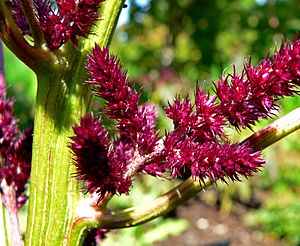Amaranth oil facts for kids
Amaranth oil is a special oil that comes from the seeds of certain plants. These plants belong to a group called Amaranthus. The two main types used for oil are A. cruentus and A. hypochondriacus. People often call these plants "amaranth grain" because their seeds are used like grains.
Contents
What is Amaranth Oil Like?
Amaranth oil is a clear liquid. It can be light or medium in color. Even when it's cold, it stays easy to pour. This oil is full of important things called fatty acids. The main ones are oleic acid, linoleic acid, and palmitic acid.
One cool thing about amaranth oil is that it can handle different temperatures very well. It stays stable whether it's very hot or very cold. This makes it useful in many ways.
How Do People Use Amaranth Oil?
Amaranth oil has many uses. You can find it in foods, like a delicate cooking oil. It also appears in cosmetics and shampoos. Beyond that, it's used to make other products. These include lubricants, medicines, rubber chemicals, and special cleaning agents.
The amount of oil in amaranth seeds is not very high. It ranges from about 4.8% to 8.1%. This is less than what you find in some other seeds used for oil. Amaranth oil freezes at a very low temperature, around -27 degrees Celsius (-17 degrees Fahrenheit).
What's Inside Amaranth Oil?
Amaranth oil is made up of different types of fatty acids. Here are the main ones and how much of each is usually found:
| Fatty acid | Amount |
|---|---|
| Linoleic acid | 50% |
| Oleic acid | 23% |
| Palmitic acid | 19% |
| Stearic acid | 3% |
See also
 In Spanish: Aceite de amaranto para niños
In Spanish: Aceite de amaranto para niños


